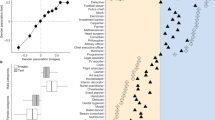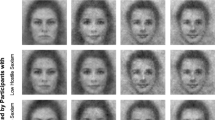Abstract
The present study analyzed whether the face-ism phenomenon, which argues that the media visually depict men with more facial prominence compared to women (whereas women are shown with greater body prominence), exists for self-selected photographs worldwide. Based on a content analysis of a sample of 6286 profile photos drawn from online dating sites in seven countries (Austria, Denmark, Hungary, Japan, Netherlands, Sweden, and the United States) in 2013, we did not find any overall gender differences in facial prominence. However, further analysis showed gender differences in facial prominence for certain age groups: whereas there were no gender differences in the 25–41 year-old age group, young women between 18 and 24 had a higher facial prominence than men, and men older than 41 had higher facial prominence than women. These changes by age are driven by a pattern wherein facial prominence generally remains stable for men, but declines for women with age. In short, older users follow more traditional gender depictions in accordance with the face-ism phenomenon, whereas among younger people, women sport an even higher facial prominence than men do. In contrast to this significant interaction between gender and age in facial prominence, we found no significant interaction between culture (as measured by Hofstede’s masculinity dimension) and gender, which indicates that culture plays no discernible role in gender differences in facial prominence, possibly because macro-level sexism (Hofstede’s masculinity dimension) and micro-level sexism (photographs of individuals online) are not the same.

Similar content being viewed by others
References
Archer, D., Iritani, B., Kimes, D. D., & Barrios, M. (1983). Face-ism: Five studies of sex differences in facial prominence. Journal of Personality and Social Psychology, 45, 725–735. doi:10.1037/0022-3514.45.4.725.
Bandura, A. (2009). Social cognitive theory of mass communication. In J. Bryant & M. B. Oliver (Eds.), Media effects: Advances in theory and research (3rd ed., pp. 94–124). New York: Routledge.
Bem, D. J. (1967). Self-perception: An alternative interpretation of cognitive dissonance phenomena. Psychological Review, 74, 183–200. doi:10.1037/h0024835.
Bornholt, J. J., Goodnow, J. J., & Cooney, G. H. (1994). Influences of gender stereotypes on adolescents' perceptions of their own achievement. American Educational Research Journal, 31, 675–692. doi:10.3102/00028312031003675.
Carter, C., & Steiner, L. (2004). Introduction to critical readings: Media and gender. In C. Carter & L. Steiner (Eds.), Critical readings: Media and gender (pp. 1–10). Maidenhead: Open University Press.
Collins, R. L. (2011). Content analysis of gender roles in media: Where are we now and where should we go? Sex Roles, 64, 290–298. doi:10.1007/s11199-010-9929-5.
Cooley, S. C., & Smith, L. R. (2013). Presenting me! An examination of self-presentation in US and Russian online social networks. Russian Journal of Communication, 5, 176–190. doi:10.1080/19409419.2013.805671.
Copeland, G. A. (1989). Face-ism and primetime television. Journal of Broadcasting & Electronic Media, 33, 209–214. doi:10.1080/08838158909364075.
Costa, M., & Bitti, P. E. R. (2000). Face-ism effect and head canting in one's own and others' photographs. European Psychologist, 5, 293–301. doi:10.1027//1016-9040.5.4.293.
Ellison, N., Heino, R., & Gibbs, J. (2006). Managing impressions online: Self-presentation processes in the online dating environment. Journal of Computer-Mediated Communication, 11, 415–441. doi:10.1111/j.1083-6101.2006.00020.x.
Emrich, C. G., Denmark, F. L., & Den Hartog, D. N. (2004). Cross-cultural differences in gender egalitarianism: Implications for societies, organizations, and leaders. In R. J. House, M. Javidan, V. Gupta, P. Dorfman, & P. J. Hanges (Eds.), Culture, leadership, and organizations: The GLOBE study of 62 societies (pp. 343–394). Thousand Oaks: Sage.
Fiore, A. T., & Donath, J. S. (2005). Homophily in online dating: When do you like someone like yourself? In CHI EA '05 CHI '05 Extended abstracts on human factors in computing systems (pp. 1371–1374). New York: Association for Computing Machinery.
Fiore, A. T., Taylor, L. S., Mendelsohn, G. A., & Hearst, M. (2008). Assessing attractiveness in online dating profiles. In Proceeding of the twenty-sixth annual SIGCHI conference on human factors in computing systems (pp. 797–806). New York: Association for Computing Machinery.
Fiske, S. T., & Taylor, S. E. (2013). Social cognition: From brains to culture. London: Sage.
Fredrickson, B. L., & Roberts, T.-A. (1997). Objectification theory: Toward understanding women's lived experiences and mental health risks. Psychology of Women Quarterly, 21, 173–206. doi:10.1111/j.1471-6402.1997.tb00108.x.
Goffman, E. (1976). Gender advertisements. New York: Harper & Row.
Hall, C. C. I., & Crum, M. J. (1994). Women and "body-ism" in television beer commercials. Sex Roles, 31, 329–337. doi:10.1007/BF01544592.
Hall, J. A., Park, N., Song, H., & Cody, M. J. (2010). Strategic misrepresentation in online dating: The effects of gender, self-monitoring, and personality traits. Journal of Social and Personal Relationships, 27, 117–135. doi:10.1177/0265407509349633.
Hancock, J. T., & Toma, C. L. (2009). Putting your best face forward: The accuracy of online dating photographs. Journal of Communication, 59, 367–386. doi:10.1111/j.1460-2466.2009.01420.x.
Hausmann, R., Tyson, L. D., Bekhouche, Y., & Zahidi, S. (2014). Global Gender Gap Report. Retrieved from http://www3.weforum.org/docs/GGGR14/GGGR_CompleteReport_2014.pdf.
Hayes, A. F. (2013). Introduction to mediation, moderation, and conditional process analysis. New York: The Guilford Press.
Hayes, A. F., & Cai, L. (2007). Using heteroskedasticity-consistent standard error estimators in OLS regression: An introduction and software implementation. Behavior Research Methods, 39, 709–722. doi:10.3758/BF03192961.
Hayes, A. F., & Matthes, J. (2009). Computational procedures for probing interactions in OLS and logistic regression: SPSS and SAS implementations. Behavior Research Methods, 41, 924–936. doi:10.3758/BRM.41.3.924.
Hitsch, G. J., Hortaçsu, A., & Arieli, D. (2010). What makes you click? Mate preferences in online dating. Quantitative Marketing and Economics, 8, 393–427. doi:10.1007/s11129-010-9088-6.
Hofstede, G. (2001). Culture's consequences: Comparing values, behaviors, institutions, and organizations across nations (2nd ed.). London: Sage.
House, R. J., Hanges, P. J., Javidan, M., Dorfman, P. W., & Gupta, V. (Eds.). (2004). Culture, leadership, and organizations: The GLOBE study of 62 societies. Thousand Oaks: Sage.
Kirkman, B. L., Lowe, K. B., & Gibson, C. B. (2006). A quarter century of Culture’s Consequences: A review of empirical research incorporating Hofstede's cultural values framework. Journal of International Business Studies, 37, 285–320. doi:10.1057/palgrave.jibs.8400202.
Konrath, S., & Schwarz, N. (2007). Do male politicians have big heads? Face-ism in online self-representations of politicians. Media Psychology, 10, 436–448. doi:10.1080/15213260701533219.
Konrath, S., Au, J., & Ramsey, L. R. (2012). Cultural differences in face-ism: Male politicians have bigger heads in more gender-equal cultures. Psychology of Women Quarterly, 36, 476–487. doi:10.1177/0361684312455317.
Krippendorff, K. (2013). Content analysis: An introduction to its methodology (3rd ed.). Thousand Oaks: Sage.
Lacy, S., Watson, B. R., Riffe, D., & Lovejoy, J. (2015). Issues and best prectices in content analysis. Journalism and Mass Communication Quarterly, 92, 791–811. doi:10.1177/1077699015607338.
Lammers, H. B., & Lammers, M. L. (1993). Face-ism in photographs: Sex and status differences. In W. F. Van Raaij & G. J. Bamossy (Eds.), European advances in consumer research (pp. 444–448). Provo: Association for Consumer Research.
Livingstone, R. W. (2004). Demystifying the nonconscious: Unintentional discrimination in society and the media. In J. D. Williams, W.-N. Lee, & C. P. Haugtvedt (Eds.), Diversity in advertising: Broadening the scope of research directions (pp. 59–73). Mahwah: Lawrence Erlbaum Associates.
Mager, J., & Helgeson, J. G. (2011). Fifty years of advertising images: Some changing perspectives on role portrayals along with enduring consistencies. Sex Roles, 64, 238–252. doi:10.1007/s11199-010-9782-6.
Matthes, J., Prieler, M., & Adam, K. (2016). Gender-role portrayals in television advertising across the globe. Sex Roles, 75, 314–327. doi:10.1007/s11199-016-0617-y.
Matthews, J. L. (2007). Hidden sexism: Facial prominence and its connections to gender and occupational status in popular print media. Sex Roles, 57, 515–525. doi:10.1007/s11199-007-9276-3.
Nigro, G. N., Hill, D. E., Gelbein, M. E., & Clark, C. L. (1988). Changes in the facial prominence of women and men over the last decade. Psychology of Women Quarterly, 12, 225–235. doi:10.1111/j.1471-6402.1988.tb00938.x.
Nisbett, R. E. (2003). The geography of thought: How Asians and Westerners think differently ... and why. New York: Free Press.
Paek, H.-J., Nelson, M. R., & Vilela, A. M. (2011). Examination of gender-role portrayals in television advertising across seven countries. Sex Roles, 64, 192–207. doi:10.1007/s11199-010-9850-y.
Park, M., & Chesla, C. (2007). Revisiting Confucianism as a conceptual framework for Asian family study. Journal of Family Nursing, 13, 293–311. doi:10.1177/1074840707304400.
Pickering, M. (2001). Stereotyping: The politics of representation. New York: Palgrave.
Prieler, M., Ivanov, A., & Hagiwara, S. (2015). Gender representations in East Asian advertising: Hong Kong, Japan, and South Korea. Communications & Society, 28(1), 27–41. doi:10.15581/003.28.1.27–41.
Rainey, L. D. (2010). Confucius & Confucianism: The essentials. Malden: Wiley.
Schroeder, J. E., & Borgerson, J. L. (2005). An ethics of representation for international marketing communication. International Marketing Review, 22, 578–600. doi:10.1108/02651330510624408.
Schwarz, N., & Kurz, E. (1989). What's in a picture? The impact of face-ism on trait attribution. European Journal of Social Psychology, 19, 311–316. doi:10.1002/ejsp.2420190405.
Smith, L. R., & Cooley, S. C. (2012). International faces: An analysis of self-inflicted face-ism in online profile pictures. Journal of Intercultural Communication Research, 41, 279–296. doi:10.1080/17475759.2012.728771.
Smith, A., & Duggan, M. (2013). Online dating & relationships. Retrieved from http://www.pewinternet.org/2013/10/21/online-dating-relationships/.
Sparks, G. G. (2006). Media effects research: A basic overview (2nd ed.). Belmont: Wadsworth.
Sparks, G. G., & Fehlner, C. L. (1986). Faces in the news: Gender comparisons of magazine photographs. Journal of Communication, 36, 70–79. doi:10.1111/j.1460-2466.1986.tb01451.x.
Spiller, S. A., Fitzsimons, G. F., Lynch, J. G., & McClelland, G. H. (2013). Spotlights, floodlights, and the magic number zero: Simple effects tests in moderated regression. Journal of Marketing Research, 50, 277–288. doi:10.1509/jmr.12.0420.
Szillis, U., & Stahlberg, D. (2007). The face-ism effect in the internet: Differences in facial prominence of women and men. International Journal of Internet Science, 2, 3–11.
Tifentale, A., & Manovich, L. (2015). Selfiecity: Exploring photography and self-fashioning in social media. In D. M. Berry & M. Dieter (Eds.), Postdigital aesthetics: Art, computation and design (pp. 109–122). Basingstoke: Palgrave Macmillan.
Toma, C. L., & Hancock, J. T. (2010). Looks and lies: The role of physical attractiveness in online dating self-presentation and deception. Communication Research, 37, 335–351. doi:10.1177/0093650209356437.
Toma, C. L., Hancock, J. T., & Ellison, N. B. (2008). Separating fact from fiction: An examination of deceptive self-presentation in online dating profiles. Personality and Social Psychology Bulletin, 34, 1023–1036. doi:10.1177/0146167208318067.
Valkenburg, P. M., & Peter, J. (2007). Who visits online dating sites? Exploring some characteristics of online daters. Cyberpsychology & Behavior, 10, 849–852. doi:10.1089/cpb.2007.9941.
Whitty, M. T. (2008). Revealing the "real" me, searching for the "actual" you: Presentations of self on an internet dating site. Computers in Human Behavior, 24, 1707–1723. doi:10.1016/j.chb.2007.07.002.
Williams, J. E., & Best, D. L. (1990). Measuring sex stereotypes: A multinational study. Newbury Park: Sage.
Wondergem, T. R., & Friedlmeier, M. (2012). Gender and ethnic differences in smiling: A yearbook photographs analysis from kindergarten through 12th grade. Sex Roles, 67, 403–411. doi:10.1007/s11199-012-0158-y.
Zuckerman, M. (1986). On the meaning and implications of facial prominence. Journal of Nonverbal Behavior, 10, 215–229. doi:10.1007/BF00987481.
Zuckerman, M., & Kieffer, S. C. (1994). Race differences in face-ism: Does facial prominence imply dominance? Journal of Personality and Social Psychology, 66, 86–92. doi:10.1037/0022-3514.66.1.86.
Acknowledgements
This research was supported by the National Research Foundation of Korea Grant funded by the Korean Government (NRF-2013S1A5A8020741).
Author information
Authors and Affiliations
Corresponding author
Ethics declarations
Conflict of Interest
The authors declare that they have no conflict of interest.
Rights and permissions
About this article
Cite this article
Prieler, M., Kohlbacher, F. Face-ism from an International Perspective: Gendered Self-Presentation in Online Dating Sites Across Seven Countries. Sex Roles 77, 604–614 (2017). https://doi.org/10.1007/s11199-017-0745-z
Published:
Issue Date:
DOI: https://doi.org/10.1007/s11199-017-0745-z




